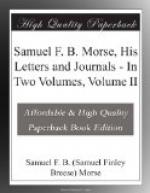Morse and his young wife returned to the North in the early summer of 1819, and spent the summer and fall with his parents in Charlestown. The young man occupied himself with the completion of the portraits which he had brought with him from the South, and his wife was busied with preparations for the event which is thus recorded in a letter of Dr. Morse’s to his son Sidney Edwards at Andover: “Since I have been writing the above, Lucretia has presented us with a fine granddaughter and is doing well. The event has filled us with joy and gratitude.”
The child was christened Susan Walker Morse. In the mean time the distressing news had come from Charleston of the sudden death of Dr. Finley, to whose kindly affection and influence Morse owed much of the pleasure and success of his several visits to Charleston.
Affairs had come to a crisis in the parish at Charlestown, and Dr. Morse decided to resign and planned to move to New Haven, Connecticut, with his family in the following spring.
The necessity for pursuing his profession in the most profitable field compelled Morse to return to Charleston by way of Washington in November, and this time he had to go alone, much against his inclinations.
He writes to his mother from New York on November 28, 1819: “I miss Lucretia and little Susan more than you can think, and I shall long to have us all together at New Haven in the spring.”
His object in going to Washington was to paint the portrait of the President, and of this he says in a letter: “I began on Monday to paint the President and have almost completed the head. I am thus far pleased with it, but I find it very perplexing, for he cannot sit more than ten or twenty minutes at a time, so that the moment I feel engaged he is called away again. I set my palette to-day at ten o’clock and waited until four o’clock this afternoon before he came in. He then sat ten minutes and we were called to dinner. Is not this trying to one’s patience?”
“December 17, 1819. I have been here nearly a fortnight. I commenced the President’s portrait on Monday and shall finish it to-morrow. I have succeeded to my satisfaction, and, what is better, to the satisfaction of himself and family; so much so that one of his daughters wishes me to copy the head for her. They all say that mine is the best that has been taken of him. The daughter told me (she said as a secret) that her father was delighted with it, and said it was the only one that in his opinion looked like him; and this, too, with Stuart’s in the room.
“The President has been very kind and hospitable to me; I have dined with him three times and taken tea as often; he and his family have been very sociable and unreserved. I have painted him at his house, next room to his cabinet, so that when he had a moment to spare he would come in to me.
“Wednesday evening Mrs. Monroe held a drawing-room. I attended and made my bow. She was splendidly and tastily dressed. The drawing-room and suite of rooms at the President’s are furnished and decorated in the most splendid manner; some think too much so, but I do not. Something of splendor is certainly proper about the Chief Magistrate for the credit of the nation. Plainness can be carried to an extreme, and in national buildings and establishments it will, with good reason, be styled meanness.”




